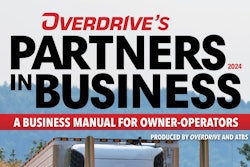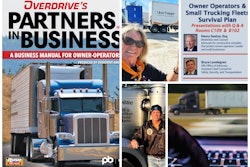A year ago during the Overdrive-ATBS Partners in Business co-presentation at the Mid-America Trucking Show, presenters Gary Buchs and Mike Hosted preached the utility of, and estimated the value in, taking an extra load each month and slowing down to improve fuel mileage.
This year, at the March 22 Partners in Business MATS session marking the release of the brand-new 140-page Partners in Business owner-operator business handbook, data presented by ATBS Vice President Hosted showed that the most successful owner-operators in 2023 took that advice to heart.
 ATBS Vice President Mike Hosted (right) and Overdrive contributor and trucking business coach Gary Buchs ran through average owner-operator numbers from 2023 and offered additional strategies for surviving the down market and positioning for success on the other side.
ATBS Vice President Mike Hosted (right) and Overdrive contributor and trucking business coach Gary Buchs ran through average owner-operator numbers from 2023 and offered additional strategies for surviving the down market and positioning for success on the other side.
Download the 50-plus slides from the 2024 PIB presentation here for a look at various data points showing how owner-operators performed in 2023.
The concept of taking the “extra load” illustrates the value add of an extra-profitable haul each month after having already met your fixed costs for that month. As such, the only costs for hauling that load are variable -- fuel, tires, maintenance, etc.
Working from ATBS client averages to make the calculation, if an owner-operator takes an additional 500-mile load each month at $2 a mile, and their variable costs are 80 cents a mile, the operator can net an extra $600 a month, or $7,200 a year.

 If an exceptionally time-efficient owner manages two extra 500-mile loads a month, that’s an added $14,400 a year in profit.
If an exceptionally time-efficient owner manages two extra 500-mile loads a month, that’s an added $14,400 a year in profit.
ATBS data from 2023 showed that’s just what owner-operators were doing last year, with average miles across all segments up by 6,337 to a yearly average of 91,396 miles.
“It was a year late probably, but truckers did run about 6,000 miles more, about 7.5% more miles, on a year-over-year basis,” Hosted said.
The other principle key to increasing profits in a down market, Hosted and Overdrive contributor/business coach Buchs said -- slowing or taking other measures to increase fuel mileage as much as possible -- also saw action in 2023. ATBS data showed truckers doing just that, with the average estimated miles per gallon across all segments increasing from 6.93 mpg at the end of 2022 to 7.07 at the end of 2023.
 That, coupled with lower average fuel costs per mile (CPM) in 2023 (shown, the black bars and lines representing 2022 for comparison to the most recent year), helped drop owner-operators’ average fuel costs by 13 cents to 60 cents a mile. In this and all the charts that follow, black bars represent 2022 months, the others 2023.
That, coupled with lower average fuel costs per mile (CPM) in 2023 (shown, the black bars and lines representing 2022 for comparison to the most recent year), helped drop owner-operators’ average fuel costs by 13 cents to 60 cents a mile. In this and all the charts that follow, black bars represent 2022 months, the others 2023.
Unfortunately for the average owner-operator, with rates in the tank in 2023, and despite lower total costs, gross revenue and net income were both lower in 2023 than in 2022. Revenue for owner-operators was down an average of 2.6%, or $4,796 to $176,817. Net income was down 2.1%, or $1,331 to $62,932.
 Independent owner-operators had a little better showing than average last year, netting $65,467.
Independent owner-operators had a little better showing than average last year, netting $65,467.
As mentioned above, total costs for owner-operators were down last year, falling by an average of $2,820, or 2.2%, to $125,960. The biggest reason for the decrease was lower fuel costs across the board, bringing operators’ average variable costs down 9%, or $6,875. On the flip side, owners’ fixed costs were up by an average of 7.8%, or $4,055. Hosted said the jump in fixed costs is “probably the highest” ATBS has ever seen year-over-year. “That is a really tough pill to swallow in a difficult market.”
 Total costs in the last two years peaked in June 2022 and hit their lowest point about a year later. Overall, though, costs were fairly close to even year-over-year.
Total costs in the last two years peaked in June 2022 and hit their lowest point about a year later. Overall, though, costs were fairly close to even year-over-year.
“I’m kind of surprised this fixed cost is as low as it is,” Buchs said. “That indicates to me we have a lot of people that don’t have a large truck payment. A lot of new entrants, their truck payment is $1,000-plus a week, so you can almost double that for a new entrant in the business. When you look at that, instead of having, say, a $260 a day fixed cost, they can be pushing $520 a day fixed cost if they’re not careful.”
Indeed, Hosted noted, in addition to rising insurance costs, equipment upgrades put off during the pandemic's high-price, low-availability truck market accounted for much of the rise in fixed costs in 2023, as deals in both new and used markets were again achievable for good-credit borrowers.
[Related: 'It's a deal': Impeccable timing yields $50K saved on a new truck]
Where do freight markets stand?
 The long-running Partners in Business program is sponsored for 2024 by the Rush Truck Centers 140 full-service-dealer network. Click/tap here to download the newly updated 2024 edition of the Partners in Business manual free of charge.
The long-running Partners in Business program is sponsored for 2024 by the Rush Truck Centers 140 full-service-dealer network. Click/tap here to download the newly updated 2024 edition of the Partners in Business manual free of charge.
In an annual survey of motor carriers of all sizes, Hosted said ATBS heard sentiments that freight is “bouncing on the bottom waiting to go up” for a while now. Fleets also expect rates to remain flat until the second or third quarter of this year. A principal reason for the long down cycle, Hosted noted, is there's still too much excess capacity in the marketplace.
ATBS’ survey asked owner-operator-heavy fleets what they saw last year in terms of capacity.
“In 2023, the average carrier lost about 16.5% of their independent contractors,” he said. “That is a huge, huge number. We’ve never seen contraction” quite as big as that. Those same fleets have “modest expectations” for growth in 2024, Hosted added.
“Part of that, I think, is they want to keep the contractors and drivers they have now happy,” Buchs noted. “Because some of them have lost freight availability or lanes, they have to balance out and try to keep the good people they have.”
The contraction begs the question, though: If so much capacity has already left markets, why haven’t rates started coming back? Owner-operators still in business are running harder, as highlighted above, Hosted said. At something of a peak in early 2022, ATBS estimated there were approximately 375,000 owner-operators in the U.S. Since then, that estimate has dropped about 20% to about 300,000. However, those still in business ran more miles during that time, offsetting the capacity that left.
“We lost 75,000 [owners], but when we added the extra miles, it’s really only equivalent to losing 50,000, because of that extra mileage,” Hosted said.
Additionally, if about half of the owner-operators who went out of business went back to being company drivers, who ran more miles themselves, the market actually gained the equivalent of 130,000 extra drivers due to the additional miles run.
 “Let’s just say company drivers only did half of what owner-operators did, the bottom line is we’re still up about 46,000, almost 50,000, IC trucks in terms of utilization,” Hosted said, using the abbreviation for independent contractor. “Because of these extra miles that are being run, we aren’t losing capacity. Actually, we’re staying pretty flat, which is why rates have stayed down longer than normal."
“Let’s just say company drivers only did half of what owner-operators did, the bottom line is we’re still up about 46,000, almost 50,000, IC trucks in terms of utilization,” Hosted said, using the abbreviation for independent contractor. “Because of these extra miles that are being run, we aren’t losing capacity. Actually, we’re staying pretty flat, which is why rates have stayed down longer than normal."
Ultimately, to have success in today’s market and to survive until rates start coming back up, owner-operators need to know their costs backward and forward to be able to pick the right loads to haul to be profitable.
“Do you know your current fixed costs per day? Do you know your variable costs? If you don’t know those numbers, you need to reassess because those numbers are changing rapidly,” Hosted said. “If you don’t know that, it’s impossible to choose the right load.”
[Related: Calculate any load's cost in relation to time, not just miles: Here's a tool that can help]
Find more detailed information about ways to simplify bookkeeping and best business practices, among a myriad of other topics, in the Overdrive/ATBS-coproduced "Partners in Business" manual for new and established owner-operators, a comprehensive guide to running a small trucking business. Click here to download the updated 2024 edition of the Partners in Business manual free of charge.









